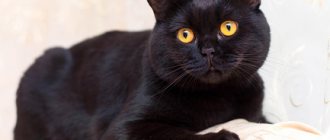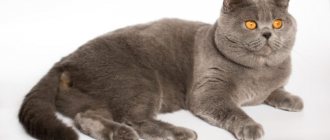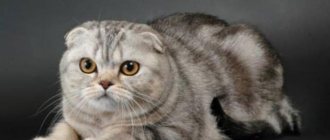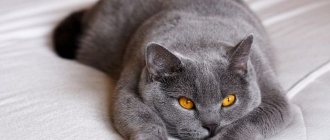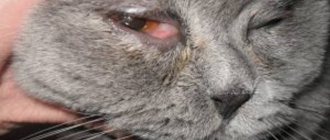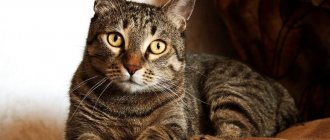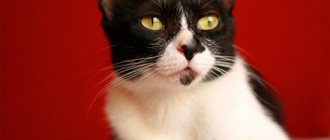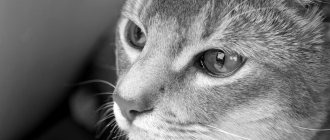Not every animal gets along easily not only with its owner, but also with other four-legged inhabitants of the house; the British cat is an ideal pet. But, if the guest is not to the liking of an intelligent Briton, the cat, by hook or by crook, will push the enemy out the door. There is no need to fight the animal’s bad habits. As Yuri Kuklachev, director and mentor of the cat theater, said, mustachioed and tabby cats do not need to be trained. They need to be nurtured and loved. What kind of animals they like, what they look like, what they eat—this information is of interest to experienced breeders. And for those who are just starting to get acquainted with the world of British breed cats.
History of the breed
According to one version, the Romans were the first to know about the existence of modern Britons. The result is a look from the mating of Egyptian and Roman cats. In the first century BC, Roman legionnaires brought representatives of the breed to England. The good fluffy coat of British cats helped them quickly adapt to new climatic conditions.
The animals were bred as mousecatchers: their hunting skills were used in the fight against rodents.
The unusual plush appearance attracted the attention of breeders. After the first specialized show, breeders began breeding cats of the British breed. At the competition, the main place deservedly went to a four-legged British dog with a blue coat. The opening of a professional exhibition took place in 1871 in London. The owner of the winner was breeder Garison Ware. At this time, the British were recognized as unusually beautiful, hardy specimens and received official recognition of the breed. The path to fame in the country began.
In the 19th century active work was carried out on the selection of the species: Persian cats were used in the study. Individuals of this species have a round, slightly flattened head in the British breed. During the war, work on breeding the breed stopped, many nurseries were forced to close. There was also a natural decline in the number of representatives of the species. Subsequently, litters from Russian, Scottish and Burmese cats were taken for crossbreeding.
Health
British cats are not susceptible to hereditary diseases and have good health.
Due to low activity, this breed is prone to obesity. Therefore, care should be taken to ensure that the pet does not overeat and that its diet is balanced. Remove the food bowl after the animal has had enough. A house on a perch will add activity to your pet’s everyday life. Offer your cat games with interactive toys: some may develop a hunting instinct and, thanks to this, animals are active even in adulthood.
Sometimes the British get their eyes watering. This is not a disease, but a feature of the breed. Remove secretions every day with a sponge soaked in chamomile infusion, unsweetened black tea, or a special product purchased at a pet store.
Like other animals, Britons can become victims of fleas, ticks and worms. Carry out an examination and give your pet the necessary medications. Visit your veterinarian regularly to help avoid health problems.
Breed varieties
Classification of animals by appearance will show what representatives of British cats are called; the names are also indicated in the photo:
British shorthair cat
Longhaired British cat
- Lop-eared.
- Long-haired.
- Shorthair.
- Chinchilla.
Crossbreed (half British)
A cross is obtained from the litter of a British cat and a representative of another feline breed, similar to the British, half-British. Known mestizos:
- a mixture of a British cat and a regular cat;
- a cross between a British cat and a Siamese cat;
- mix with Siberian cat;
- To obtain the Scottish Fold species, British and Scottish healthy individuals were crossed.
Mixed breeds combine the best traits from both breeds.
British cat photo
Owner reviews
On the Internet you can find many reviews about British Shorthair cats. In most cases, owners describe their pets as independent, calm and non-aggressive animals that require little attention. Some people are disappointed with their pets, and all because they do not like to be held and only accept affection when they want it.
Indeed, the British are ideal for those who do not expect too much from a cat. These are inconspicuous, self-sufficient animals, but at the same time non-conflicting and not mischievous. We can say that representatives of this breed behave like true Englishmen - confidently and reservedly.
Character and habits
British cats can be safely left at home alone for several hours. Therefore, they are perfect for both homebodies and always busy workaholics. The character traits and characteristics of British breed cats are visible when the animal first appears in the house. Pets quickly become attached to the home and people around them, without choosing their favorites.
They treat caresses and displays of tenderness from their owner with aristocratic dignity. May not respond with purrs to hugs and cuddles. The mustachioed handsome man will come up on his own when he wants to be petted.
By the way, in the understanding of a pet there is no concept of an owner; the cat behaves like a full member of the family.
If the cat did not like the new person in the apartment, the pet will express dissatisfaction with its behavior. Sometimes animals try to manipulate the owner, begging, for example, for a certain product every day. Representatives of the British breed are friendly with children. But they demand respect for their noble person.
British cats are scrupulous about cleanliness: they will never sit in a dirty litter box. Typically, pet owners try to clean the container immediately after the animal’s toilet. The pet refuses to go to the right place: she doesn’t like something. And with her behavior she wants to convey this to the person.
For girls
British cats are capricious and subject to frequent mood swings. You won’t be spoiled with her: she’s like a queen; basic information shows the character of noble people. They either rub their muzzle against your hand or run away indignantly. British cats have traits of little girls in their personalities. Pets, depending on their mood, like to lie next to their owner. But the queen does not allow excessive familiarity. The weight of a female differs from the size of the largest British cat: a girl is usually 3-4 kg less.
Up to a year old, the behavior of a British kitten, regardless of gender, does not differ, but over time, the animals’ reaction changes significantly. What character a British cat has during this period depends on the hormonal background of the matured pet.
If a person does not plan to breed kittens, it is better to sterilize the adult. In this case, you can avoid problems associated with your pet’s sexual activity. Behavior will become softer.
When purchasing a British cat for breeding, pay attention to the fact that the titled beauty needs to select a gentleman for mating from time to time. Also, care about feeding during the period of gestation of kittens increases significantly. The animal's body needs vitamins and minerals more than ever.
In boys
The handsome man with a mustache is much larger than the female of the same breed. An adult cat weighs about 6-8 kg. The greatest weight is more than 12-13 kg: this is the largest British cat. For comparison, a Siberian cat weighs about 12 kg. The British cat's habits and characteristics show that the animal looks more massive and behaves much more impressively. Cats are just as attached to their home as cats. The British have a very difficult character: some pets are capable of being cunning and pretending when they need it.
Owners who know everything about British cats and do not take a cat into their home for breeding: the animal must be neutered. To divorce British cats, they look for a cat every month based on a photo, otherwise the gentleman will behave aggressively. An unneutered cat that requires mating may leave marks in corners and on upholstered furniture, lose weight, and become mischievous. Breeding animals need a more careful approach when it comes to care and feeding. An adult pet that has completed its breeding career is sold in nurseries much cheaper than active animals.
British cat photo:
Colors of British cats
The following colors are typical for the British:
- Blue. Gray wool without light hairs. Skin is blue.
- A monochromatic color is considered if the skin, undercoat and coat itself are the same color, and there is not a single spot. Lilac is a combination of pink and blue. The nose and paws are purple. Eyes - copper or orange.
- Chocolate is a rich brown color.
- Black is a jet black color. Sometimes kittens are born with black fur, but it fades over time. This adds complexity to breeding black pets.
- White - pinkish skin and cool coat tone. Yellow spots are not acceptable.
- Cinnamon is a cinnamon color, similar to light brown.
- Fawn is a combination of creme brulee and pink.
- Marble/classic - dark spots or stripes on light sides. The eyes are copper with dark eyeliner.
- Bicolor - predominance of white at least 1/3, but not more than 1/2;
For the long-haired variety of the breed, all colors are acceptable except white and color point.
Pros and cons of the breed
The pros and cons of British cats were based on the opinions of breeders and reviews of pet lovers.
| pros | Minuses |
| An unusual pet that looks like a teddy bear. A soft fur coat that you want to touch and cuddle. | Loves independence: if he is not in the mood, he will not let you cuddle him. |
| Attachment to the inhabitants of the house. There are known cases: a Briton pretended to be sick every time they wanted to give him into the wrong hands. And he came to life before our eyes when the danger had passed. | They need serious education. An untrained cat will cause a lot of trouble for the owner. |
| They get along with children. In a good mood, your plush pet will frolic and play. | They are difficult to train: pets are wayward. |
| Get along with other pets: dogs, cats. | May cause an allergic reaction |
| Good health, strong immunity | |
| A clean animal: if there are no obvious problems (the cat can inform about the problem with marks), if the kitten was not torn away from its mother at an early age and taught the correct habits. |
Minor disadvantages of the breed boil down to proper upbringing, feeding and caring for a British cat, which is necessary for all pets. The main problem is the question of allergies: allergic or not? And in the reaction of the human body to the fur and saliva of an animal. You cannot have a furry creature if an allergy sufferer lives in the apartment. The British cat has a dense, voluminous pile; when shedding, hair loss will increase. It will be difficult for an allergic person to live with such an animal.
silver chinchilla
Physical activity
British Shorthairs are part of a privileged caste of aristocrats of the cat world, detached from worldly worries and labors . They sleep and rest much more than other cats. Rumor has it that the British are able to spend up to 20 hours a day in the arms of Morpheus - and this is not considered a deviation.
Peak age-related activity occurs in childhood and adolescence. Over the years, the British become heavier, acquire sedateness and try to lie down more and not rush around after the trinkets scattered on the floor.
British kittens play as selflessly as others - they can fly up curtains, jump from an ambush, chase their owner's feet, defend their favorite toy or get into fights with brothers/sisters. The demonstration of intimidation looks especially comical when the kitten periodically runs at the offender with its back arched upward and its tail raised.
If the household members are busy with their own affairs or are absent, the young Briton will find entertainment on his own - he will begin to chase scraps and corks, fallen pencils and pens around the apartment, tinker with toys, tear newspapers, twist a roll of toilet paper, pull out dresser drawers or artistically gnaw out the owner's ficus tree. Growing pets splash out their seething energy, running from corner to corner and demolishing all objects that prevent them from gaining maximum acceleration. That is why young Britons need play comfort zones, where they will equip a multi-tiered cat house with toys and a scratching post.
Important! In the absence of a play complex, you will have to actively play with the cat for at least 2–3 hours a day. Do not forget to periodically change worn-out toys, and also remember that one game is repeated until the animal loses interest in it.
If possible, take the kittens to the dacha without letting them outside the perimeter . They happily chase birds and insects, climb trees, lie on the grass and eat it. To prevent parasite infestation, apply tick and flea repellent to the withers. For walks outside the garden area, purchase a harness and leash, but your pet must be specially and for quite a long time accustomed to these attributes.
Return to content
Breed Features
Plush pet lovers know all about the cats of the British Isles. They received strong immunity from their ancestors. The cat is suitable for living both in a house outside the city and in an apartment. British breed cats are considered to be long-lived. The average life expectancy of British breed cats is about 13-14 years: cute British cats will delight your family for a long time.
Even after moving to England, British cats showed themselves to be excellent hunters. Therefore, the question of whether British cats catch mice disappears. The British are excellent mousecatchers. Animals were brought home to kill rats and mice, long before the breed was recognized.
Huge saucer eyes, fluffy fur coat. One image of a pet, and the picture of a cute animal cannot leave your head: the cat looks like a soft toy.
There is no need to take a kitten that is too small from its mother: in the future, problems will arise with raising a little Briton. Buy a kitten from a nursery: the cub will receive all the necessary vaccinations and be taught hygiene skills.
The variety of diet has a great influence on the appearance and shine of the fur of a British Shorthair cat. It is necessary to choose food with a vitamin-mineral complex in its composition and alternate it with natural food.
How do the British differ from the Scots?
Behavior
The character and habits of the British become fully formed at approximately 2 years of age. If up to this point the behavior of British cats has not begun to correspond to the owner’s ideas, then, most likely, nothing further can be changed. Properly raised pets are clean, quickly accustomed to the tray, so care and maintenance are not difficult. Long sleep is vital for an animal. A cat can sleep for 15-20 hours in a row. If peace is disturbed, the British become angry and impatient. After a healthy sleep, the cat will gladly delight its owner with its presence.
